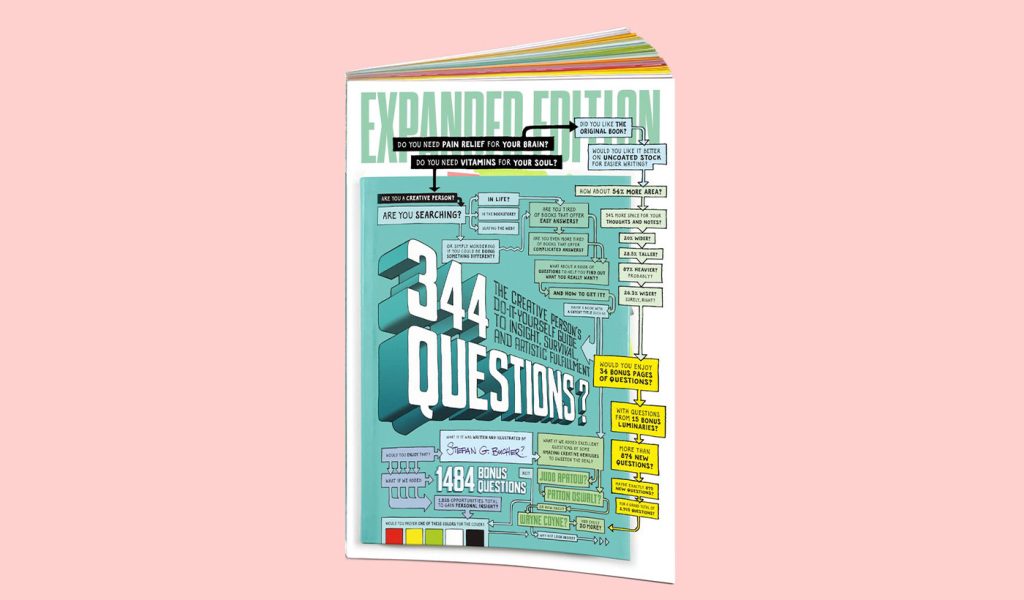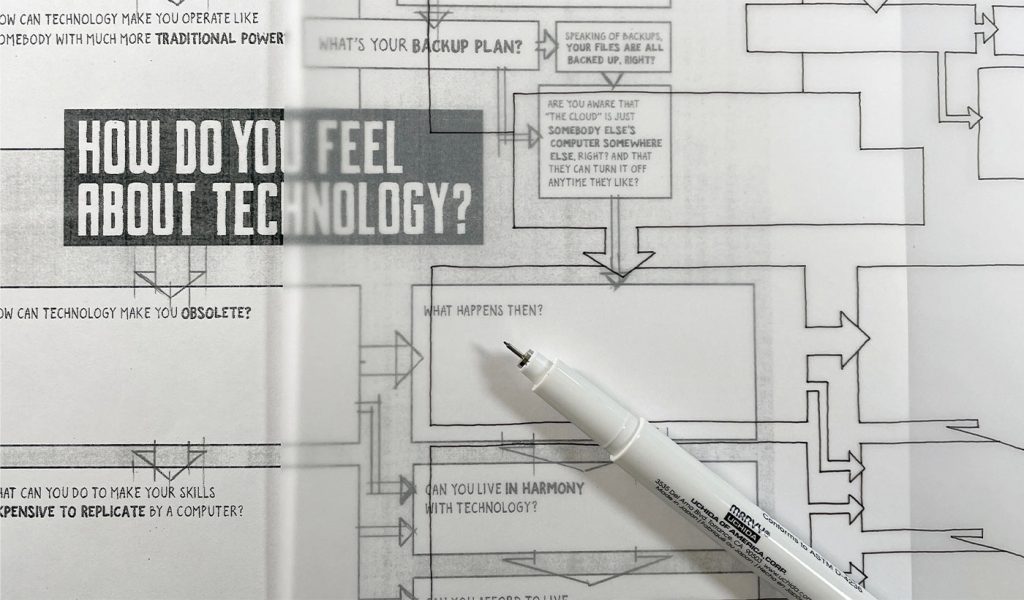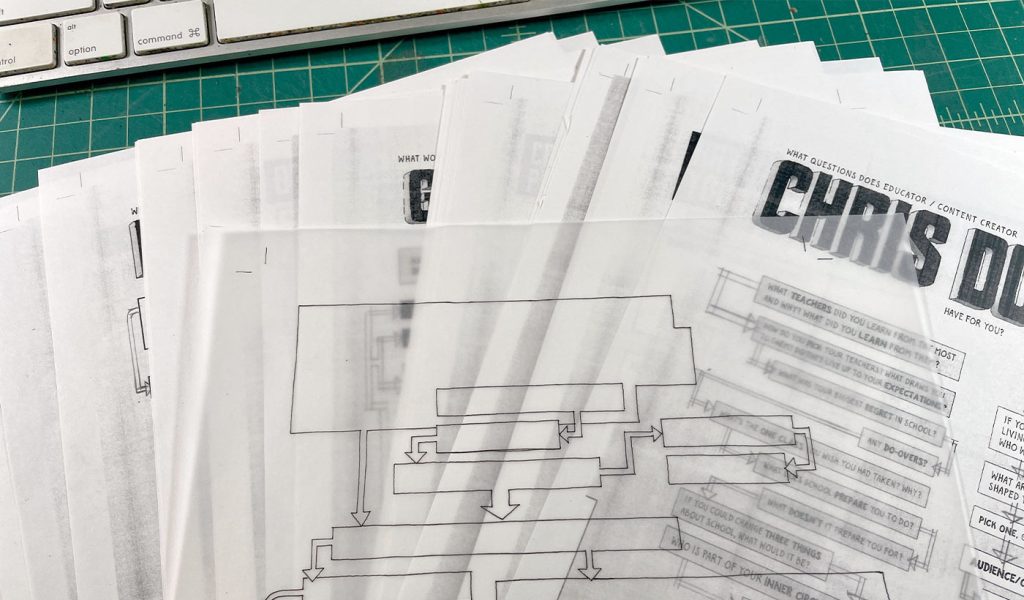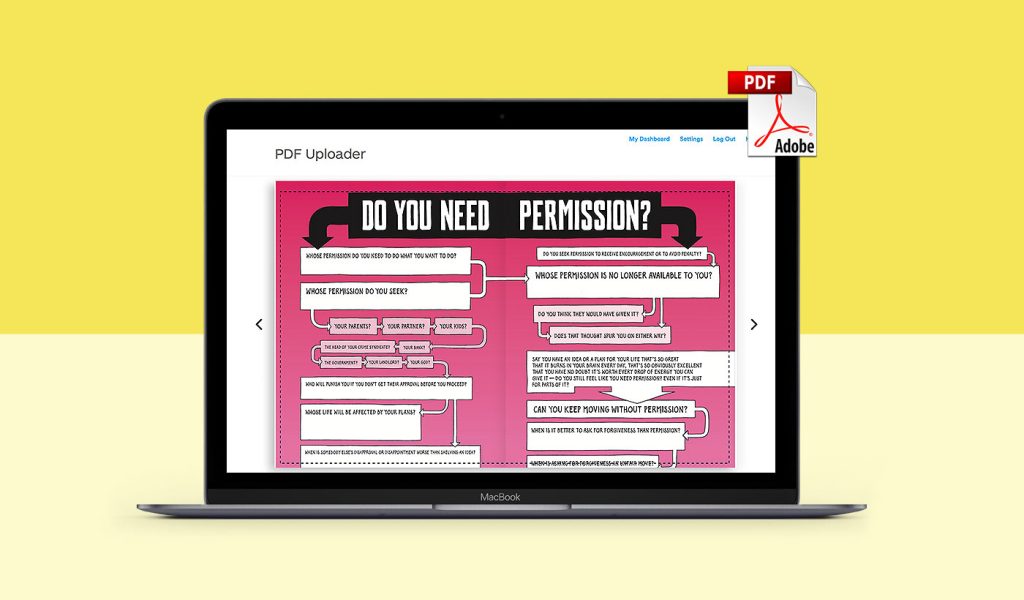344 Questions: Behind the Book with Stefan G. Bucher
Described as a therapy session in a book, graphic narrator and design illustrator Stefan G. Bucher knows a lot about the creative process of self-discovery. His latest bestseller, 344 Questions, offers hope—and yes, a path to answers—for those feeling unmoored in life. We discuss the origin story of his book, his penchant for print, and his advice to fellow self-publishers.
1. Can you explain how your research reading self-help books informed this book?
There are, I think, people who trust that they’re inherently solid and lovable. By contrast, I really internalized the idea that I’d have to improve myself to get to that point—that I’d have to earn that sense of worth. So I delved deeply into the world of self-help literature. There are lots of books that give sound advice, but I usually got to a point with most of them where the author would share some personal backstory that made me distrust how applicable their wisdom was to me—some inherited advantage or stroke of good luck that isn’t replicable.
Between that frustration and having started talk therapy, I wondered if I could write a self-improvement book without that moment of, “Well, sure that worked for you, but my circumstances are totally different!” Doing it through a series of questions was that approach for me.
2. You mentioned that 344 Questions has its roots in your first book, All Access. Can you explain?
My first book, All Access—The Making of Thirty Extraordinary Designers, was a behind-the-scenes look at the lives of thirty contemporary graphic designers I admire. I was at a point in my career as a graphic designer where I wasn’t sure if I wanted to continue in the field. Interviewing people who were farther ahead on the same road was my way of finding that answer.
Aesthetically, the book was a tour de force. I crammed ideas into every possible part of that thing! There are Easter eggs everywhere! For one thing, I graphed out all the work samples in the book on a person-by-person timeline that was hidden on the inside of the dust jacket.
When it came time to release a paperback, the publisher suggested we turn that timeline into a foldout. Crucially, they asked if I wanted to put something on the back of that foldout. I thought, “What a great opportunity to let readers be a part of the book!” I made a flowchart of questions I was asking myself based on the interviews in the book, and I invited readers to answer them for themselves, too.
A few years later, Nikki McDonald at Peachpit/Pearson asked if I wanted to write a book for her and if I had any ideas. I suggested turning that graph into a book of its own, and that became 344 Questions.
(By the way, it’s 344 Questions because 344 Design is the name of my studio. There are 2,702 questions in the expanded edition. So…2,358 bonus questions, free of charge!)

3. Why do you feel questions lend themselves best in one’s process of self-discovery?
344 Questions is a therapy session in a book, and questions are at the heart of therapy. A good therapist will never give you concrete advice, they’ll ask you questions that guide you to your own answers. Once you find an answer that is truly your own, it’s much easier to move forward in your chosen direction.
And let’s face it—I don’t know your life. I can’t even guess at your particular circumstances. But looking at my own journey and drawing on the lives of friends and colleagues, I can ask questions that I think will be helpful. At the very basic level, it’s “Where are you? Where do you want to be? And how do you get there from here?”
Throughout the book, I look at different areas of life and creative practice and refract them through the prism of that fundamental idea—breaking things down into more and more specific questions, creating wild webs of questions to challenge and inspire people to find clarity.
4. The tortured creator is a common trope in today’s culture. Can you expand on why you chose creators as your target audience?
Of course, my immediate answer is that we are all creators. For some of us, it takes the form of drawings or paintings or music. For others, it’s about creating machines or processes in the world. I think all of it is about greater human connection. But I’m personally known as a visual creator, so giving it that title gave me a bit of earned credibility.
I’m glad you asked about the trope of the tortured creator, though, because I absolutely hate it. I’ve worked as a creator all my life, and I used to buy into the idea of the tortured artist. I grew up depressed, stuck in a scholastic environment I’d charitably describe as adversarial. So the idea that suffering somehow ennobled my work was attractive. It felt like a free upgrade. I leaned into the self-presentation that my work was better because I suffered so much to make it—by working harder and by being more neurotic.
Telling people about the endless nights and the crazy process also helped me with my impostor syndrome. “You might not like my work, but you can’t deny how hard I worked on this, how much it cost me physically and mentally!” Not that anyone ever openly challenged me like that. I think it was mostly a defense against my inner critic.
Through therapy, and perhaps just as a function of age, I came to recognize the Suffering Artist™ as a hugely damaging idea. Whenever I’ve done good work, it’s not because of my depression or my neurosis—it’s good work in spite of that. Looking back, I’ve always done my best work when I was loose and excited about the subject matter and the people I was helping.
But the myth is stubborn. It’s much easier to be taken seriously if you frown. There’s no smiling in fine art; comedies don’t win Oscars. And I think it’s a terrible loss for all of us. One set of questions in the book asks,
“Do you take pride in your suffering?”
“Why?”
“Is joy as honorable as suffering?”
I think it is, but in the Western world, we’ve been inculcated with the belief that any happiness has to be earned. You get what you pay for, so if it comes easy, it’s not worth that much. I think that ethos has cost all of us dearly at every level.
As to the original question of why I chose creators as my target audience, I am a creator myself, and after 30 years of putting out work for a fairly ridiculous range of clients, I feel I have something of worth to give back. My main mission is to help people avoid as many of the boring old potholes as possible. Hopefully, that will free them up to make new and interesting mistakes that expand the world for all of us!

5. What is one question in your book that you find yourself returning to? Why?
“How would you live your life if somebody told you you’re on the right track?” As I get older, I still find myself looking for some secret rules that govern life—a code I can crack, so I can know that I’m “doing life right.” Intellectually, I know that that’s now how it works, but faith in a positive outcome isn’t easy for me. So that’s the question I keep coming back to. How would I live my life if someone told me that I’m doing great? The destination might be the same, but I suspect I’d be a lot happier along the way.
6. You’ve been both a self-published author and a traditionally published one. What have been the benefits and drawbacks of each?
The biggest benefit of traditional publishing is reach—being in bookstores all over the world, letting people discover my books as they’re browsing. As a professional designer of high-end books, I also enjoy the different production options I can use if I’m in full control of the process—cloth covers, embossing, foils, silks, ribbons, special bindings, and pop-ups.
But the cost of traditional publishing is substantial. Printing even a short run of a simple book puts you into five figures, and that’s printing abroad with a long lead time.
Of course, you also have to find a publisher, and you have to come to an agreement on the content of the book. That can be a great, collaborative process that makes the book better, but it can also be a process rife with conflict. Most times, it’s a mix of both. Over the years, I’ve become much better about setting up my projects very clearly and found publishers that agreed with that setup.
Self-publishing is a lot more nimble and makes a lot of books possible that wouldn’t be viable with traditional publishers—the subject matter is too niche, the author doesn’t have a large enough following, the book is too topical to go through the traditional production pipeline.
At the same time, self-publishing requires much greater discipline from authors. There are fewer cooks in the kitchen, yes, but there are also fewer people who will spot mistakes or raise concerns. And honestly, the option of fixing mistakes along the way and simply uploading a revised file is seductive. You really need to be committed to quality control in a way that traditional authors don’t have to be. You’re the architect and the carpenter, the structural engineer and the bricklayer.
One huge advantage I’ve found with making this expanded edition of 344 Questions available exclusively through Blurb is pricing. I was able to add 34 extra pages, make the book 54% larger, and put it on uncoated paper so it’s easier to fill out. With all that, I could still keep the price under $20 and get a little royalty on each copy. I don’t think a traditional publisher could’ve matched that. I also made the choice not to sell the book on Amazon. Had I checked that box and opted for zero royalties, the book would cost $31.89. Do I think the book is worth $31.89? Absolutely, but that would have put it out of reach for too many people. As it is, I’m using the URL 344questions.com to redirect readers to the page in the Blurb bookstore.

7. What draws you to the format of print in the Digital Age? What do you feel is print’s role in the world today?
I grew up with parents who loved books, and that love transferred to me. I won’t bore you with the common serenade of the tactile pleasures of print books. I simply find that I interact differently with information in a printed piece than I do with information on a screen. I absorb the information better, it’s less strain on my eyes, and it’s easier to skip between sections, to scribble notes, to dog-ear pages, or add bookmarks. Physical books allow me to segment and annotate the information in a much easier, faster way than digital documents do.
I do think we have a responsibility to use resources responsibly. Let’s not make trash. If you’re going to chop down trees and use lots of water and electricity to make paper, use that paper for something that has purpose—that brings wisdom or joy.
On a more poetic note, books are something I’ll leave behind. Anything I do in the digital space depends on the continued existence of the software I used or the websites I used to distribute the work. I have hundreds of drawing videos on YouTube. If YouTube ever decides that they’ll no longer show 240p videos, there go the first hundred. If the company ever folds, that work is essentially gone from the world unless I’m still around to upload it elsewhere. And how long will that last?
Through books in wide release, I’ve now achieved flea market immortality. Barring some global catastrophe, there’s a decent chance that a copy of one of my books will pop up at a flea market a hundred years from now. And I love that idea—that someone might find it and say, “Wow! Look at this crazy thing! That’s from a hundred years ago! What a world that must’ve been where somebody got to make something so odd!”
8. I recently learned that 344 Questions is your bestselling book so far. Why do you think that is?
I think 344 Questions found such a great audience because it’s my most immediately helpful book. It directly addresses pains and worries we all share, and it helps you find a way forward. It’s pain relief for the brain and vitamins for the soul.
9. You also made a holiday edition. What was the thinking behind re-versioning? Do you plan to have other editions?
You know, that’s one of the joys of on-demand printing. As a designer, I have the tools to create versions, and all it costs me is a few minutes to upload that alternate cover. It’s a great way to keep the book fresh in people’s minds, and some people really loved that green and red look. I suspect that a pink version will appear in time for Valentine’s Day.
10. What words of wisdom would you give to creators looking to self-publish?
Be disciplined. You get to do whatever you want, whenever you want. That’s a recipe for putting out something half-baked or never going to print. Be very clear and precise about why you want to publish this book. Who is it for? What do they care about? What will make this project a success in your eyes? That last one is very important, and it’s a question I ask all my clients early on. Is the very existence of the book about its success? Is it only a success if you sell 10,000 copies? Or if you get reviewed in major magazines? Is the book meant as a calling card to give you credibility? How do you measure that? I could write a new chapter of 344 Questions just about this. Just be clear about your intentions with the book.
11. Self-promotion can be hard for many creators. What’s your advice to them?
This is absolutely my weakest area, and it’s usually why I work with traditional publishers. I’d go back to my general advice: Be clear about your intentions for the book. And then work backward. The path to acclaim is very different from the path to big sales. Unless you’re already famous, I’d avoid the temptation of hiring PR firms. Any halfway serious PR team will charge you a minimum of $10,000 for a three-month engagement, and the odds of making that money back are slim.
For myself, I will send copies to contributors and a few colleagues who I hope will mention the book favorably to their audience. I used to chase magazine reviews. Those were very gratifying to see when they happened but rarely led to increased sales. If you get lucky to be reviewed by an influential writer online, that can make a huge difference. Maria Popova reviewed the first edition of 344 Questions on The Marginalian (formerly Brain Pickings) when it came out, and I can confidently attribute at least 10,000 copies just to that one post. But that was a lottery win.
12. In the spirit of question-asking, what question do you wish we asked? (And, of course, what’s your answer?)
I wish you’d asked, “What is your hope for this book?” and I’d tell you: I hope this book will find someone who needs to feel a little less alone and a little more understood. I hope it will be a flashlight in the dark for some and a sail on the ocean for others. I hope it’ll help people breathe deeper and maybe fall (back) in love with their lives a little.

***
Feeling inspired to enter the world of writing and bookmaking? Create and self-publish your book today.

